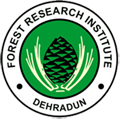
Haryana Forest Flora
A Comprehensive Database of Ligneous Plants of Haryana (India)
Designed & Developed by Bioinformatics Centre,Forest Research Institute, Dehradun



| Family: Combretaceae | Genus: Terminalia | Species: Terminalia catappa Linn.( देसी बादाम ) |
Habit |
Leaf |
Flower |
Fruit |
Bark |
| Synonym | Badamia commersonii Gaertn., Buceras catappa (L.) Hitchc., Catappa domestica Rumph. | Flower Color | Greenish |
| Common Name | Indian almond-wood tree | Flower Type | Spikelet |
| English / Trade Name | Indian almond-wood tree, bastard almond, Andaman badam. | Flowering Period | Jan-March |
| Vernacular /Local Name | Desi badam | Fruiting Period | April-June |
| Altitude | Upto 800 m. | Fruit Type | Nut |
| Habit | Tree | Fruit Details | The pale green fruit is the size and shape of an almond in its shell. Some varieties become reddish-purple when ripe. The nuts are edible, taste like almonds and are eaten. |
| Habitat | Tree of coastal areas throughout the warm tropics. Grows best in moist tropical climates. The tree is well adapted to sandy and rocky coasts. | Bark Type | Rugged |
| Distribution | Australia, Cambodia, India, Japan, Laos, Malaysia, Thailand, Vietnam. | Bark Details | Hard, dark brown in colour, rugged. |
| Distribution in Haryana | , Gurgaon, Morni-Pinjore | Origin | Native |
| Leaf Type | Simple | ||
| Leaf Arrangement | Alternate (leaves born singly along stem) | ||
| Leaf Shape | Ovate | ||
| Description of Species | Indian almonds are spreading trees with large, leathery, oval leaves which turn red before they fall. The tree has a distinctive shape, its horizontal branches growing in wide spreading circles at different levels on the trunk. The greenish - white female - and male flowers are on the same tree; these flowers are inconspicuous and not very showy. The pale green fruit is the size and shape of an almond in its shell. Some varieties become reddish-purple when ripe. The nuts are edible, taste like almonds and are eaten. | Leaf Details | Leaves alternate oval with short petioles, spirally clustered at the branch tips, 15-36 cm long, 8-24 cm wide, dark green above, paler beneath, leathery and glossy. They turn bright scarlet, dark red, dark purplish-red, or yellow. |
All rights reserved by Forest Research Institute, Dehradun
The contents of this website may not be reproduced partially or fully, without due permission from The Director, Forest Research Institute, Dehradun -248006 (Uttarakhand), If referred to as a part of another publication, the source must be appropriately acknowledged. No part of this web-portal i.e. source code, any picture, image, graphics, text, design may copy or reproduce in any form of publication / software / web application development / creation. The contents of this website can not be used in any misleading or objectionable context. The Copyright Act 1957 and Copyright (Amendment) Act, 2012, Govt. of India will be applicable for any dispute.